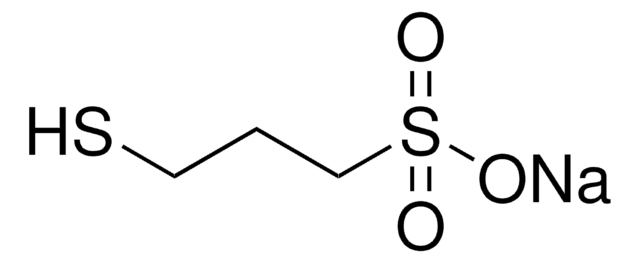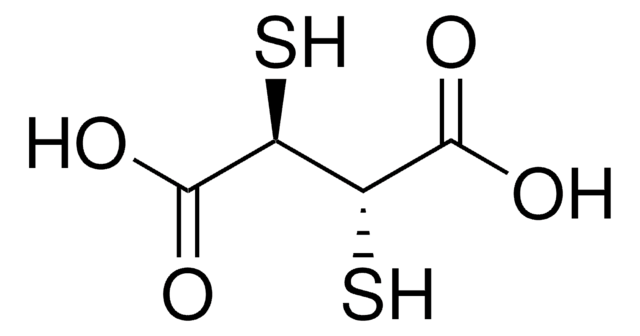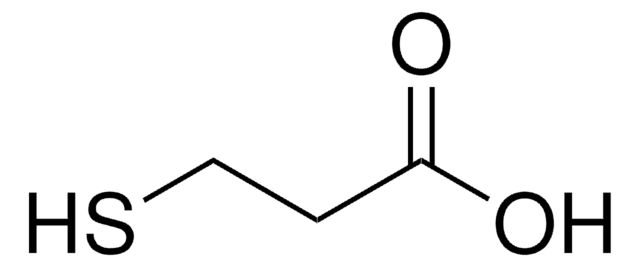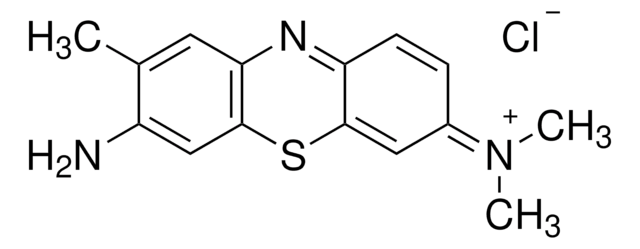D8016
Sodium 2,3-dimercaptopropanesulfonate monohydrate
95%
Synonym(s):
2,3-Dimercaptopropanesulfonic acid sodium salt monohydrate, DMPS
Sign Into View Organizational & Contract Pricing
All Photos(1)
About This Item
Linear Formula:
HSCH2CH(SH)CH2SO3Na · H2O
CAS Number:
Molecular Weight:
228.29
Beilstein:
3734863
EC Number:
MDL number:
UNSPSC Code:
12161900
PubChem Substance ID:
NACRES:
NA.25
Recommended Products
description
zwitterionic
Quality Level
Assay
95%
form
powder
mol wt
228.29 g/mol
mp
215 °C (dec.)
storage temp.
2-8°C
SMILES string
O.[Na+].[O-]S(=O)(=O)CC(S)CS
InChI
1S/C3H8O3S3.Na.H2O/c4-9(5,6)2-3(8)1-7;;/h3,7-8H,1-2H2,(H,4,5,6);;1H2/q;+1;/p-1
InChI key
XMUHNMQFDVIWGU-UHFFFAOYSA-M
Looking for similar products? Visit Product Comparison Guide
Related Categories
General description
Sodium 2,3-dimercaptopropanesulfonate monohydrate is a chelating agent for heavy metals.
Application
Sodium 2,3-dimercaptopropanesulfonate monohydrate has been used in a study to assess its use as an antidote against non-metallic pesticides as nereistoxin insecticides. It has also been noted in a review of existing chelating agents for the treatment of heavy metals and metalloid intoxication.
Storage Class Code
11 - Combustible Solids
WGK
WGK 3
Flash Point(F)
Not applicable
Flash Point(C)
Not applicable
Personal Protective Equipment
dust mask type N95 (US), Eyeshields, Gloves
Choose from one of the most recent versions:
Already Own This Product?
Find documentation for the products that you have recently purchased in the Document Library.
Customers Also Viewed
Santiago Iglesia-Turiño et al.
Plant physiology, 142(2), 742-749 (2006-08-22)
The mercury (Hg) accumulation mechanism was studied in rape (Brassica napus) plants grown under a Hg concentration gradient (0 microm-1,000 microm). Hg mainly accumulated in roots. Therefore, the presence of phytochelatins (PCs) was studied in the roots of the plants.
Swaran J S Flora et al.
International journal of environmental research and public health, 7(7), 2745-2788 (2010-08-19)
Chelation therapy is the preferred medical treatment for reducing the toxic effects of metals. Chelating agents are capable of binding to toxic metal ions to form complex structures which are easily excreted from the body removing them from intracellular or
Sodium dimercaptopropane sulfonate as antidote against non-metallic pesticides
Chen, Z., et al.
Acta Pharmacologica Sinica, 25, 534-534 (2001)
Holger A Scheidt et al.
Biophysical journal, 109(3), 586-594 (2015-08-06)
Many proteins are anchored to lipid bilayer membranes through a combination of hydrophobic and electrostatic interactions. In the case of the membrane-bound nonreceptor tyrosine kinase Src from Rous sarcoma virus, these interactions are mediated by an N-terminal myristoyl chain and
Christy C Bridges et al.
Toxicology and applied pharmacology, 285(2), 110-117 (2015-04-15)
Secretion of inorganic mercury (Hg(2+)) from proximal tubular cells into the tubular lumen has been shown to involve the multidrug resistance-associated protein 2 (Mrp2). Considering similarities in localization and substrate specificity between Mrp2 and the breast cancer resistance protein (Bcrp)
Our team of scientists has experience in all areas of research including Life Science, Material Science, Chemical Synthesis, Chromatography, Analytical and many others.
Contact Technical Service









